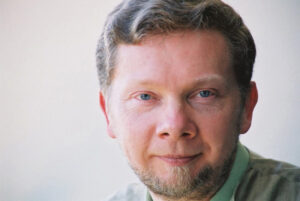Book Summary: Practicing the Power of Now by Ekhart Tolle
A gentle, practical companion for those seeking presence in the midst of chronic illness.
Practicing the Power of Now is a concise guidebook created to help readers bring the deeper theoretical teachings of The Power of Now into everyday life. Rather than staying in abstract ideas, this book invites the reader to begin applying presence and surrender through short, simple exercises and reflections.
While Tolle’s work is not written specifically for those with chronic illness, the essence of what he teaches — resting in the moment, detaching from the storm of thought, and observing the present without judgment — is deeply relevant to nervous system regulation. It has techniques and suggestions that may become a soft companion on the healing journey.
Presence and Chronic Illness
For those living with chronic fatigue, pain, or complex conditions like ME, fibromyalgia, or LongCovid, the present moment can often feel like a place to escape — full of discomfort, symptoms, and thoughts that spiral. But this is exactly why presence is so powerful.
In these moments, the mind may become hyperactive, scanning for threats or desperately trying to solve the problem. This state of hypervigilance can keep the nervous system stuck in survival mode. What Eckhart Tolle points to in his work is a quiet shift in direction: not to deny what’s happening, but to gently observe it without fear. This observation acts as a signal to the body and mind that it is safe to rest.
By returning to the “Now”, even for a moment, we interrupt the cycle of reactivity. That’s where self-regulation can begin.
A Gentle Introduction
Practicing the Power of Now distills the teachings of Tolle’s seminal work, The Power of Now, into actionable exercises, helping readers move beyond intellectual understanding to embodied presence. Tolle emphasises that true peace is found not by thinking about the present – or thinking about the idea of becoming present, but by experiencing it directly.
The practices can offer a way to gently shift attention from persistent thoughts about the past or future to the sensations and experiences of the current moment, part of moving towards a more “meditative way of living” if you like. This shift can help soothe the nervous system and create a sense of stability.
Take a deep breath and gently let it fall away from you on the exhale. Bring attention to your hands: Direct your focus to feeling into your fingers, the palms of your hands—notice any tingling, warmth or cool air, or subtle sensations.
A Note on Mindfulness
Tolle has expressed reservations about the term mindfulness, suggesting that it may imply an overemphasis on the mind. Instead, he encourages a state of no-mind, where one becomes fully present without the constant chatter of thoughts.
As he explains:
“When a thought subsides, you experience a discontinuity in the mental stream — a gap of ‘no-mind.’ At first, the gaps will be short, a few seconds perhaps, but gradually they will become longer. When these gaps occur, you feel a certain stillness and peace inside you.”
— Eckhart Tolle
This approach offers a way to find rest and healing in a moment-by-moment way without the pressure to “achieve” anything.
The Science Behind the Book
Although Tolle’s work is presented in simple non-scientific language, many of his insights have been supported by modern neuroscience. His teachings about presence, non-reactivity, and interrupting mental loops align with core concepts in:
Neuroplasticity – the brain’s ability to rewire itself in response to new experiences and awareness.
Default Mode Network deactivation – when the mind is no longer ruminating or over-processing, and instead becomes quiet and inwardly still.
Parasympathetic nervous system activation – the body’s rest-and-digest system, which becomes more active during deep presence and acceptance.
A Harvard study led by Dr. Britta Hölzel in 2011 found that just eight weeks of mindfulness led to measurable changes in brain structure. Researchers observed increased gray matter density in regions associated with learning, memory and emotional regulation — all key areas affected in chronic stress and illness.
These findings confirm what so many people experience intuitively: when we become more present, we feel more resilient, more stable, and more ourselves. Tolle’s invitation to “watch the thinker” is not only spiritually profound — it is also biologically transformative.
“Presence is the key to freedom, so you can only be free now” — Eckhart Tolle
Practices of presence and observation without judgment have also been shown to reduce symptoms of anxiety, improve emotion regulation, and increase resilience — all part of the journey for those recovering from chronic illness.
Presence as a Doorway to Emotional Safety
For many people living with chronic illness, emotional safety can feel far away. When the mind or body is in pain, or when symptoms are unpredictable, the nervous system often stays in a state of hypervigilance — constantly scanning, bracing, or shutting down.
Tolle’s emphasis on presence offers more than peace of mind — it opens a doorway to emotional safety. Presence allows the body to begin letting go of its survival posture. The breath softens. The heart rate slows.
For some, the idea of “being present” can sound abstract — but in practice, it means feeling safe enough to stop striving for just a moment, and let the moment be what it is.
Presence doesn’t require you to feel better first. It simply invites you to pause inside the moment you’re already in — and let that be a beginning.
Beginning to Practice The Techniques
Incorporating the exercises from Practicing the Power of Now into daily life can be as simple as taking a few moments to focus on your breath, observe your surroundings without judgment, or feel the sensations in your body.
You may have heard of these techniques by different names; focus breathing, orienting, or somatic tracking. No matter which labels we use, these practices can help create a sense of safety and ease, supporting the body and mind.
A Simple Exercise from The Book: Conscious Breathing
This exercise focuses on bringing attention to your breath, serving as a gateway to present-moment awareness.
Steps:
Find a Comfortable Position: Sit or lie down in a quiet space where you can be as comfortable as is possible for you.
Close Your Eyes: Gently close your eyes if you can, to minimise external distractions.
Bring Attention to Your Breath: Notice the sensation of the air entering and leaving your nostrils. Feel the rise and fall of your chest and abdomen with each breath.
Observe Without Altering: Allow your breath to flow naturally. The goal is not to control it but to observe it as it is.
Anchor in the Present: If your mind wanders, gently bring your focus back to the breath. Each inhalation and exhalation serves as an anchor to the now.
Practicing this exercise for one to two minutes each day can begin to cultivate a deeper sense of presence and reduce stress.
You’re Not Doing It Wrong
It’s common to try presence practices and feel like you’re doing them “wrong” — especially when thoughts keep coming or when the body feels too agitated to sit still.
But Tolle reminds us that presence isn’t about silencing the mind or forcing stillness. It’s about awareness without judgment.
Try approaching these practices like you would approach a small child learning something new: gently, kindly, without pressure. Even the intention to pause is meaningful.
You can softly say to yourself:
“I’m learning how to be here. That’s enough for today.”
That’s the heart of this work. Not perfection — presence with kindness.
Key Takeaways from Practicing the Power of Now
Presence heals. You don’t have to think your way out of illness. Sometimes, just being here is enough.
You are not your thoughts. The mind can create fear loops, but you can gently learn to witness them instead of believing them.
No-mind is peaceful. Stillness is not emptiness—it is the foundation of clarity and healing.
Freedom begins with acceptance. Surrendering to what is does not mean giving up. It means creating the conditions for something new to arise.
You don’t need to “achieve” anything. You are allowed to slow down. To breathe. To just be.
"I'm learning to be here. That's enough for today."
Meet the Author of the Book: Eckhart Tolle

Eckhart Tolle is a spiritual teacher and best-selling author born in Germany and now based in Canada. After a spiritual awakening in his late twenties, he went on to write The Power of Now and A New Earth, two of the most influential spiritual books of the 21st century. His teachings focus on presence and the liberation found in the present moment.
Tolle’s soft-spoken delivery, clear insights, and compassion have touched millions around the world. He offers a spiritual path that is gentle and inward-focused — accessible to people from all walks of life.
Amari's Perspective
This small book — Practicing the Power of Now — feels more approachable than Tolle’s larger works. For those who are fatigued or foggy, or whose nervous systems are in constant overdrive, reading spiritual theory can feel like “too much.”
So many of the people I work with live in fear of slowing down or stopping. They believe that if they stop pushing, stop fighting, they will collapse. But Surrender is not defeat — it’s the first step to being found. This is what Tolle is pointing towards in his work. A guidance towards the present moment, without needing to fix, change, or push anything away.
Next Steps: Where to Go From Here
Take your time. Let the words in this article land slowly. You don’t have to take it all in at once. You only need to begin — just as you are doing.
💗 Try a meditation to help you Surrender into the Now — I created this for you to soothe, soften, and support your nervous system.
💗 Browse other Book Summaries and articles in the Resources section of this website for spiritual support and mindbody insights.
💗 If you’re looking for another simple presence practice inspired by Tolle, I’ve shared one in the blog post An Instant Reset: Soothe Your Mind and Body in Five Simple Steps — it’s drawn from this same little book and adapted to support your nervous system gently.
💗 If you’d like guidance, you can book a Mind-Body-Spirit Coaching session to support your next steps with compassion.
You are not broken. This moment is already enough. And you are already held.
With warmth and stillness,
Amari 💗
💗 Meet The Author 💗

Amari Love
Amari Love is a coach and writer who specialises in mind-body-spirit healing for chronic illness. With postgraduate degrees in English Literature, Writing, and Film, and having completed additional studies in Somatic Healing, Trauma Recovery, Gut Health and Meditation, she brings a rare blend of intellectual insight and heart-led guidance. Drawing deeply from her own journey of recovery after decades of chronic invisible illness, cancer and Longcovid, her work is grounded in the principles of TMS (The Mindbody Syndrome), Neuroplasticity, and Emotional Integration — supported by a spiritual approach to wholeness and inner alignment.
Amari is a registered health coach with the UKI Health Coaching Association, reflecting her commitment to high standards of integrity and compassionate, science-backed care. She also cares deeply about making this path more visible — so that others, and future generations, have access to real answers that go beyond managing symptoms.
This work is here to help you rewire your brain, restore the nervous system, and reclaim a life of clarity, balance, and peace.
Disclaimer: The content in this article is shared for educational and reflective purposes only. It is not intended to replace personalised medical advice, diagnosis, or treatment. Please consult a qualified healthcare professional before making decisions about your health or wellbeing.


